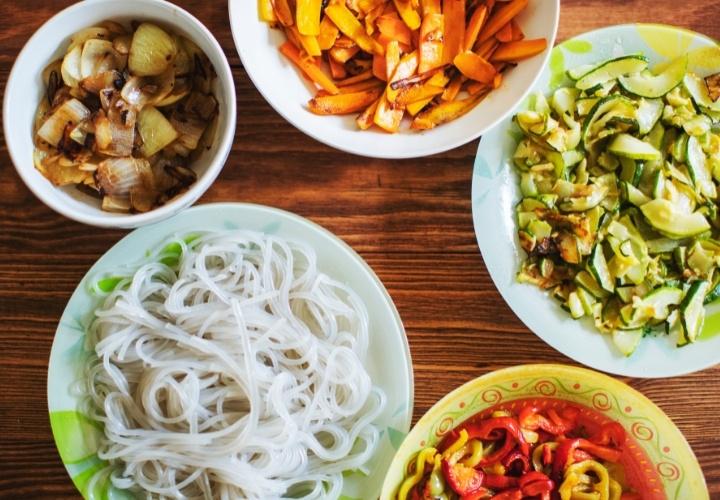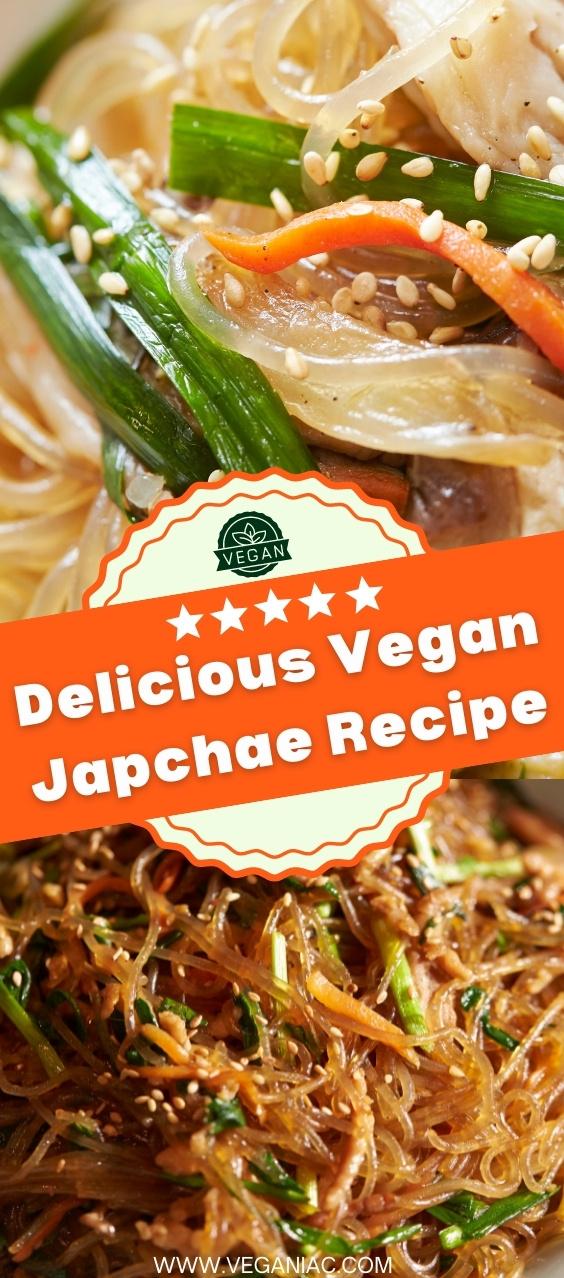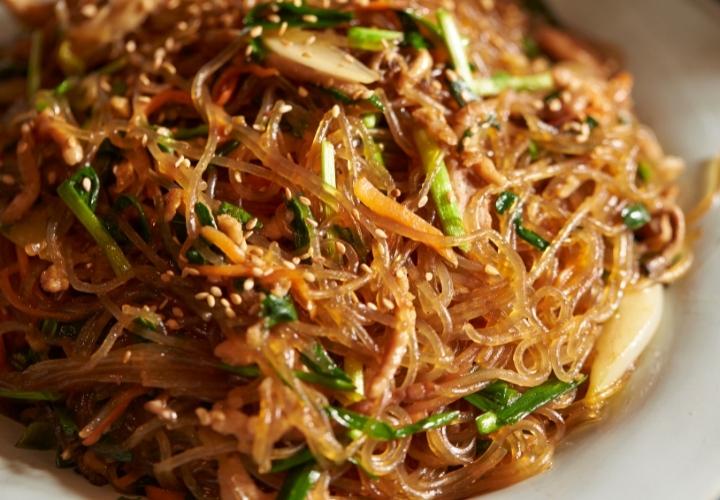This post may contain affiliate links
In less than 30 minutes, you can enjoy this plant-based, gluten-free, and tasty Vegan Japchae dish – This famous and healthful Korean glass noodle stir-fry is loaded with proteins, fresh vegetables, and delicious sweet potato glass noodles! It really doesn’t matter if you serve it hot or cold; the characteristic umami flavours will come out!
What is Japchae?
Korea has a diverse range of culinary choices, most of which mix a variety of flavors, textures, hues, and aromas in a single dish! Japchae is one of the most popular Korean recipes. Originally created for royalty, this meal is now frequently served at special festivals and events.
Meat, noodles, and vegetables are typically mixed in a mildly sweet and flavorful sauce. Japchae is seasoned with soy sauce and sugar, and the sesame oil adds a nuttiness. The use of springy and translucent sweet potato noodles called Dangmyeon sets this meal apart from other Asian noodle dishes.
The Korean word japchae (잡채) literally translates to “mixed veggies.” The major ingredient in this traditional Korean cuisine, however, is Korean sweet potato starch noodles (dangmyeon, also known as glass noodles). Japchae is a must-have dish for traditional holidays and special occasions.
For classic japchae, chewy and springy noodles are combined with thin slices of beef (or pork) and various vegetables in a slightly sweet and salty sauce. The addition of an egg garnish (jidan, 지단) is also customary.
But for our vegan Japchae recipe simply leave out the meat and add more mushrooms or other veggies to make vegan japchae. Tofu that has been pan-fried works well as a meat substitute. I add pine nuts, finely chopped, to the mix every now and again.

Vegan Japchae Recipe
In case you haven’t tried this recipe yet, now is the time to do so! It’s one of several Korean meals that has created a name for itself around the globe to its distinct texture and taste.
Traditionally made with meat, this vegan version uses extra mushrooms to replace it. I absolutely adore how they soak up flavors and have a meaty texture in every bite, so much that if you’re just starting vegan, you won’t even miss the meat!
Because each vegetable is stir-fried separately, Korean Japchae takes a long time to prepare. It is done in this way to ensure that the vegetables have the proper texture and color, as each requires a varied amount of cooking time. In case you have a similar taste like me and just want a fast, nutritious, and delicious lunch or dinner side dish, just fry everything together! It’s easier and quicker, and it tastes just as good! But make absolutely sure you have a big enough pan or wok!
What are Dangmyeon Noodles?
Because of their translucent look when cooked, it’s also known as glass noodles or cellophane noodles. Instead of wheat and rice, sweet potato starch is used to make this type of noodle.
I adore how the slick, flexible texture of these noodles contrasts with the crispiness of the vegetables I used! Furthermore, it is naturally gluten-free. When I’m in the urge for some, I can readily find them in Korean stores or Asian markets. You can always get them online if you don’t have one near you.
Ingredients and Substitutes for Vegan Japchae
Sweet Potato Noodles: this dish may be made with any variety of noodles! Although the structure and appearance will not be same, you will still be able to experience the dish’s delicious flavors! In a hurry, handmade noodles, rice, udon, or soba noodles can be used.
Vermicelli or spaghettini are also good options, but they are a little too thin. When cooking, always read and follow the package instructions.
Sauce: For an umami-rich flavor, I used a strong Tamari sauce. It’s gluten-free and has a stronger flavor than soy sauce. You can use any sweetener instead of coconut syrup if you don’t have any available.
Sesame oil is one of the top ingredients that give an Asian meal its unique flavor. But in case you don’t have any, peanut oil will do. In case you want to make it a little spicier, add extra sriracha or crushed red chili flakes.
Veggie Protein: Brown button mushrooms were utilized as a source of plant protein, although any type will suffice. You can boost the protein content of this recipe by using a meat replacement like store-bought vegan beef or crispy tofu.
Vegetables: I made this dish using garlic, onions, red bell pepper, carrots, zucchini, scallion, and baby spinach. Broccoli, cabbage, green, red or yellow peppers, Chinese chives, sprouts, or bok choy are plenty more veggies that would work effectively. Any vegetable you can stir-fry will suffice.
Garnishing: A hearty coating of a sesame seed, coriander and thinly sliced scallions, adds an authentic Asian flavor to the dish! Garnish with lime slices for those who like it a little tangier.
Share the image below to your Pinterest board if you like this Delicious Vegan Japchae Recipe!

Vegan Japchae Recipe
Ok, here is the full recipe for this delicious traditional Korean meal
Ingredients
- 7 oz sweet potato glass noodles Dangmyeon
- 9 oz mushrooms (brown button mushrooms)
- 1 chopped onion
- 1 sliced red bell pepper
- 1 zucchini medium size, sliced
- 3-4 minced garlic cloves
- 1 sliced carrot
- 2 scallion stalks roughly chopped
- 3 oz baby spinach
- 3 TBSP of frying oil
For the sauce:
- 4 TBSP of tamari sauce, strong (you can also use soy sauce)
- 1 TBSP of coconut syrup
- 1 TBSP of sesame oil, toasted
For the garnishing:
- sesame seeds (be generous)
- coriander
- scallions
- lime
Directions
- To cook the noodles, the first step is to take a large pot of water and bring it to a boil. Cook for 5 minutes, or according to package directions, after adding the sweet potato noodles.
- The noodles should then be drained and rinsed under cold water to cease cooking. To make them shorter, place them in a dish and slice them using scissors a few times.
- Toss with a few drops of sesame oil to coat (it will keep the noodles from sticking together).
- To make the sauce, combine all of the ingredients ( coconut syrup, tamari and sesame oil) in a small bowl, and set it aside.
- In a large pan, heat 1-2 Tbsp of oil over high temperature. Cook the mushrooms, (don’t stir them), for about 3 minutes, until the mushrooms are golden-brown on one side.
- Next, turn the mushrooms over, lower the heat slightly, and cook for another 2 minutes. Stir in a small amount of the sauce until the mushrooms are equally coated. Remove your pan from the heat and set it aside.
- Heat another tbsp of oil in the same pan (or if you’re using a wok). Cook the onions for 2 minutes, or until the onions are translucent. Add in bell peppers, zucchini and carrots and cook for around 3 minutes
- Cook for, or until they are cooked but still have some crunch.
- Finally, add spinach and garlic and put them aside to wilt the spinach. Add the vegetables to the noodle bowl (or move the noodles into the veggies pan to serve it hot as a stir-fry). Toss in the remaining sauce thoroughly.
- Serve Vegan Japchae with sesame seeds, scallions, coriander, and lime wedges on the side, either cold as a salad or warm as a stir-fry. Enjoy!
Conclusion
I hope you’ve enjoyed this vegan Japchae recipe as I did making it. Be sure to go through the entire article for the best results, it’s the little details that matter when it comes to cooking the most amazing meal. If you’re having any issues or suggestions on this Vegan Japchae, please wright your thoughts down in the comments sections, and I’ll be happy to reply as always.








